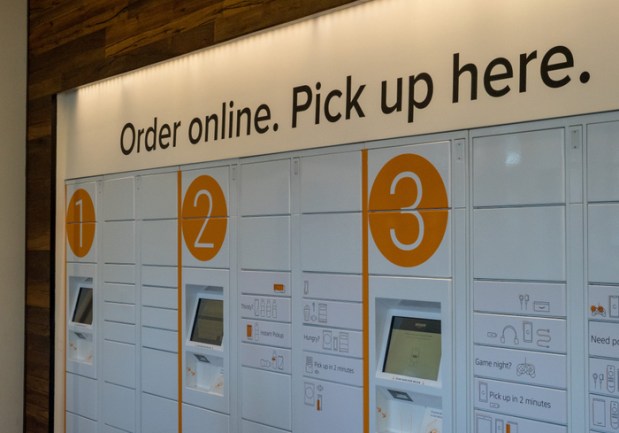The Future Of In-Store Pick-Up With Lockers

As retailers expand their omnichannel efforts with in-store pickup, they are faced with a challenge: What is the best way to help their customers retrieve their orders from their brick-and-mortar stores? Home Depot, for example, is taking a page out of the Amazon retail playbook by installing lockers in many of its locations to support its in-store pick-up service. The move enables the retailer to get items to online customers right away instead of waiting for their purchases to be delivered to their home.
The idea is “customers’ expectations with shopping are changing, and they want as many options as you can possibly give them,” Home Depot spokeswoman Lana Johnston has said. As a result, Home Depot hopes to have lockers in all its brick-and-mortar stores within three years. With the technology, the home improvement retailer is able to provide its customers with the “convenience of self-service and time savings,” Johnston said.
In addition, the lockers help Home Depot “maintain its lead over Amazon and others in the home improvement space,” Neil Saunders, managing director of GlobalData’s retail division, has said. And as it stands, Home Depot is a different kind of retailer than Amazon: Home Depot’s CFO Carol Tomé has said that the company is a project retailer and not an item retailer. “We also help you when you have a problem,” Tomé has said. “If your bathroom is leaking water, that’s a very different need than if you are trying to match a sweater to your eye color.”
At the same time, digital revenue is booming for the home improvement chain: In February, Tomé revealed that Home Depot saw a 21.5 percent growth in online sales last year, and that its online business now makes up almost 7 percent of its overall business. In addition, 46 percent of those sales were picked up inside of a store. And these sales can generate incremental revenue for Home Depot, as those pick-up sales often resulted in the customer purchasing additional products.
The Amazon Locker Effect
Home Depot isn’t the only retailer seeing the in-store sales benefits of having lockers: Amazon’s Lockers, for example, may be encouraging shoppers to make quick trips to Whole Foods stores. Research from inMarket showed that “micro” visits — or those between three and five minutes — increased 11 percent at locations that had the lockers compared to a 7 percent rise in stores without lockers since last August, according to reports from March.
The idea is that Amazon customers who stop at Whole Foods won’t just visit the store to retrieve their packages: They might peruse the selection and purchase a drink or a promotional item. And, for Amazon, in particular, their trips also provide an opportunity for Whole Foods to make shoppers aware of changes at the grocery chain. (Amazon recently expanded its Prime discount program at Whole Foods, for example.)
Beyond brick-and-mortar settings, Amazon sees applications for its lockers in residential properties. Amazon has reportedly signed contracts with apartment owners and managers representing more than 850,000 units across the U.S. to begin installing locker systems in their buildings. Several of the nation’s largest operators, including AvalonBay Communities Inc., Equity Residential, Greystar and The Bozzuto Group, have already signed up.
The locker system, which is dubbed Hub by Amazon, accepts packages from all carriers, and the orders don’t even have to be made on Amazon. The lockers will be available only to residents, who will receive a notification when they have a package, along with a code to retrieve it. Lockers will be placed both indoors and outdoors, equipped with cellular connectivity so apartment owners don’t have to connect it to an Ethernet cable. And he locker program seeks to help landlords with a major pain point of running a property – handling the packages received each day, which can take several hours to sort. Staff at one of The Bozzuto Group’s properties, for example, spend about three hours each day sorting packages.
Pickup Towers and Lockers
Beyond pick-up lockers, other retailers are choosing other form factors for systems that allow customers to retrieve their online orders without having to wait in line. Walmart, for example, has pickup towers – and, yes, they also come equipped with pickup lockers to enable customers to receive merchandise such as televisions. To use the pickup towers, which are 16 feet tall and approximately 8 feet wide, customers place an order online and receive a barcode on a digital recipe. When they enter the store, they scan the barcode from their phones on the machine’s scanner to pick up the order in a process that takes less than 60 seconds.
Already, Walmart said that the kiosks are receiving an “overwhelming positive” reception and that customers have picked up more than a half million orders since their introduction. The retailer debuted the first of the self-service kiosks in the fall of 2016 in a Bentonville, Arkansas store. And, going forward, Walmart is rolling out 500 more kiosks.
Will other retailers follow in the footsteps of Home Depot, Amazon and Walmart with pickup lockers and towers? That remains to be seen, but these applications show that retailers are considering automated options as alternatives to waiting at a staffed counter — or at home — for an online order.
